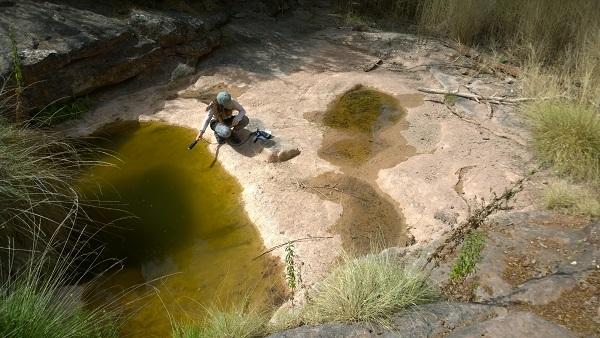Beyond traditional metrics

Credit: UNIVERSITY OF BARCELONA
Functional metrics in ecology -indicators based on the biological features of the organisms, in this case, water invertebrates- could help researchers to detect the impacts of human origins in temporary rivers, according to a new study carried out by experts from the Research Group Freshwater Ecology, Hydrology and Management (FEHM) of the Department of Evolutionary Biology, Ecology and Environmental Sciences of the Faculty of Biology of the University of Barcelona and the Biodiversity Research Institute (IRBio).
The study also counts on other participating experts from the Institute of Environmental Assessment and Water Research (IDAEA-CSIC), the University of the Balearic Islands and the University of Parma (Italy).
The new study, published in Journal of Applied Ecology, presents a series of functional metrics that can contribute to the improvement of the assessment and management of temporary rivers. Some of these can even be applied regardless of the intermittence of the water flow. Moreover, these functional metrics seem to be more precise in the detection of environmental degradation of the ecosystem compared to the ones so far used, which will be more and more important regarding the context of climate change.
Improvement of the management and protection of temporary rivers
About 50% of the water network in the world consists of temporary or intermittent rivers, that is, rivers with a variable surface flow which changes in space and time creating three aquatic phases: flowing and disconnected pool aquatic phases, and completely dry phase. This can occur in the riverheads, in low parts and over the whole river. As a result, biological communities of these rivers also change over the aquatic phases, finding different groups of organisms that adapt to the environmental conditions they find.
The variability of the flow of this type of river makes it hard for the researchers to make an accurate diagnosis in accordance with the objectives form the EU Water Framework Directive (WFD), since the existing valorization tools are not adapted to this case. In the Mediterranean climate areas, many rivers can be temporary but we can also find some with human activity or anthropic impact- such as water extraction for agriculture purposes, hydrological alterations, geomorphological impacts, pollutants, invasive species, etc. Apart from this context, we need to add the effects of climate change, which show a significant increase of these rivers in certain areas of the world.
However, the assessment tools to determine the ecological state through biological indicators were designed, mostly, “to be applied to permanent and seasonal rivers, and this means they cannot always be applied to temporary rivers”, notes researcher Maria Soria, first author of the article and member of IRBio and FEHM research group, who is conducting her doctoral thesis under the supervision of the lecturer Núria Bonada (UB) and Núria Cid (INRAE, France).
This study is framed within the European project LIFE+ TRivers, launched by a consortium formed by the Research Group FEHM from the Faculty of Biology of the University of Barcelona, the Institute of Environmental Assessment and Water (IDAEA-CSIC), the Catalan Water Agency (ACA) and the Júcar Hydrographic Confederation (CHX). Its objective is to study the hydrology and ecology of temporary rivers, and create new tools to improve its management and decision-taking in the field of management regarding the Water Framework Directive.
Temporary rivers: beyond traditional metrics
As part of the study, the experts assessed the ability of a set of biomonitoring metrics to detect anthropic impacts both in perennial and temporary rivers. In the experimental design, researchers conducted analyses that included both aquatic phases: flowing and disconnecting pool water phases. In particular, the team analyzed the response of several metrics based on water macroinvertebrates over the gradient of natural intermittence of flow and anthropic impacts.
The final objective of the study was to find out the combined effect of both perturbations -natural as a result of temporality and anthropic too- in two sets of metrics: the ones currently used by the water biomonitoring and which are based on the taxonomic richness and biological indexes (IBMWP, IMMiT and IASPT), and functional metrics, which use as a reference the biological traits of macroinvertebrates.
According to the conclusions, when traditional metrics are applied, the natural intermittence of water flow can confuse the evaluation process of the biological quality of rivers. Therefore, it is necessary to recalibrate these metrics if we wish to detect anthropic impacts in temporary rivers. As an exception, IBMWP -used when the water flows- seems to be efficient to detect anthropic impacts in perennial and temporary rivers. “However, there are studies that observed how this index could differ between dry and wet years, that is, the space and temporary hydrological variability of temporary rivers could provide untrusted results, especially in less predictable seasonal climates”, note the authors of the study.
As stated in the study, the functional metrics can detect anthropic impacts in permanent and temporary rivers when the water flows and, in addition, some of them can be applied when the river has disconnected pools. In particular, one of the functional metrics with the highest potentiality is functional redundancy -it would be the number of taxons that contribute in a similar way to the ecosystem function- of the community of invertebrates.
This study, thus, opens new perspectives to the application of functional metrics in daily protocols of river sampling.
###
Media Contact
Rosa Martínez
[email protected]
34-934-031-335
Related Journal Article
http://dx.




